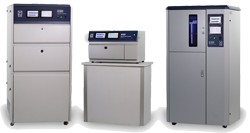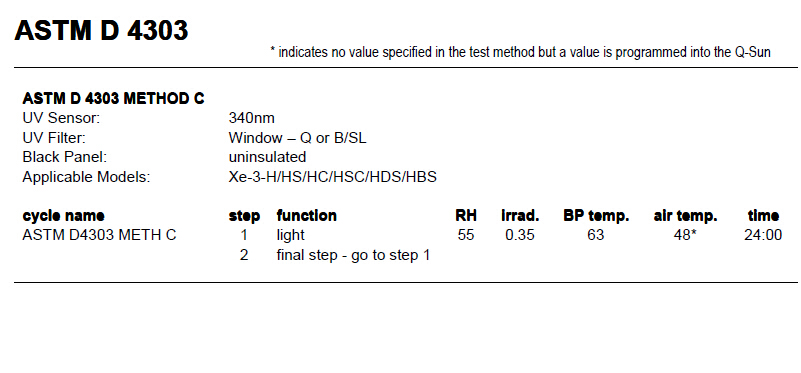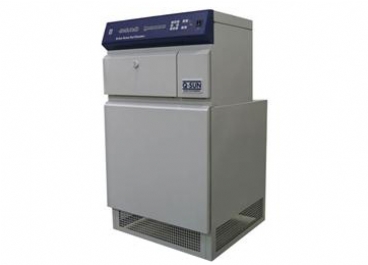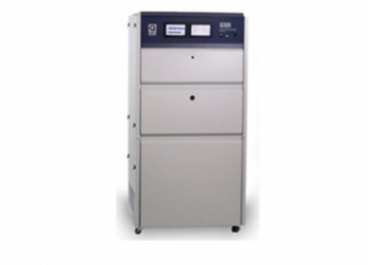耐候性試驗
Weathering Testing
咨詢熱線
18566398802ASTM D4303-2016
ASTM D4303-2016標準介紹
藝術材料中使用的著色劑光穩定性的標準測試方法:
描述了4種加速長期室內照明對藝術材料的影響的測試方法。
1.測試方法A-暴露于透過玻璃過濾片的自然光;
2.測試方法B-暴露于日光熒光燈的輻照度;
3.測試方法C-暴露于透過玻璃的模擬日光輻射的Q-SUN氙弧燈;
4.測試方法D-暴露于冷白熒光燈和透過鈉鈣玻璃片的熒光紫外燈的輻照度。
Q-sun氙燈試驗箱ASTM D4303測試方法

ASTM D4303英文版本(節選)
Significance and Use
The retention of chromatic properties by a colorant over a long period of years is essential in a work of art. Accelerated exposure simulates color changes that may reasonably be expected. The producer and the user of artists' materials, therefore, can be apprised of suitable colorants.
Variations in results may be expected between the test methods. Also, some variation may be expected when the same test is repeated. Variations in Methods A and B are due to differences in outdoor conditions that are not accounted for in testing to equivalent radiant exposures. Information on sources of variability and strategies for addressing variability in laboratory accelerated exposure tests is found in Guide G141.
This standard does not cover factors other than lightfastness that can affect the permanence of art materials.
1. Scope
1.1 Four test methods to accelerate the effects of long term indoor illumination on artists' materials are described below. One of the natural daylight methods and one of the xenon-arc methods are used to categorize the lightfastness of colorants.
1.1.1 Test Method A—Exposure in southern Florida to natural daylight filtered through window glass.
1.1.2 Test Method B—Exposure in Arizona to natural daylight filtered through window glass.
1.1.3 Test Method C—Exposure in a non-humidity controlled xenon-arc device simulating daylight filtered through window glass.
1.1.4 Test Method D—Exposure in a humidity controlled xenon-arc device simulating daylight filtered through window glass.
1.2 These test methods are used to approximate the color change that can be expected over time in colorants used in artists' materials exposed indoors to daylight through window glass.
Note 1—The color changes that result from accelerated exposure may not duplicate the results of normal indoor exposure in a home, art gallery, or museum. The relative resistance to change, however, can be established so colored materials can be assigned to categories of relative lightfastness.
Note 2—Users who wish to test colored materials under fluorescent illumination should consult Practice D4674.
1.3 Lightfastness categories are established to which colorants are assigned based on the color difference between specimens before and after exposure.
1.4 Color difference units are calculated by the CIE 1976 L*a*b* color difference equation.
1.5 These test methods apply to colored artists' materials.
1.6 The values stated in SI units are to be regarded as the standard. The values given in parentheses are for information only.
1.7 This standard does not purport to address the safety concerns, if any, associated with its use. It is the responsibility of the user of this standard to establish appropriate safety and health practices and determine the applicability of regulatory limitations prior to use.
2. Referenced DocumentsASTM Standards
D2244 Practice for Calculation of Color Tolerances and Color Differences from Instrumentally Measured Color Coordinates
D4302 Specification for Artists Oil, Resin-Oil, and Alkyd Paints
D4674 Practice for Accelerated Testing for Color Stability of Plastics Exposed to Indoor Office Environments
D5067 Specification for Artists Watercolor Paints
D5098 Specification for Artists Acrylic Dispersion Paints
D5724 Specification for Gouache Paints
D6901 Specification for Artists Colored Pencils
E284 Terminology of Appearance
E1347 Test Method for Color and Color-Difference Measurement by Tristimulus Colorimetry
E1348 Test Method for Transmittance and Color by Spectrophotometry Using Hemispherical Geometry
E1349 Test Method for Reflectance Factor and Color by Spectrophotometry Using Bidirectional (45:0 or 0:45) Geometry
G24 Practice for Conducting Exposures to Daylight Filtered Through Glass
G113 Terminology Relating to Natural and Artificial Weathering Tests of Nonmetallic Materials
G141 Guide for Addressing Variability in Exposure Testing of Nonmetallic Materials
G151 Practice for Exposing Nonmetallic Materials in Accelerated Test Devices that Use Laboratory Light Sources
G155 Practice for Operating Xenon Arc Light Apparatus for Exposure of Non-Metallic Materials
溫馨提醒:本ASTM D4303-2016可能存在更新的版本,建議尋找ASTM D4303-2016的發行商確認。


 氙燈加速老化試驗箱
氙燈加速老化試驗箱
 粵公網安備 44060402000067號
粵公網安備 44060402000067號